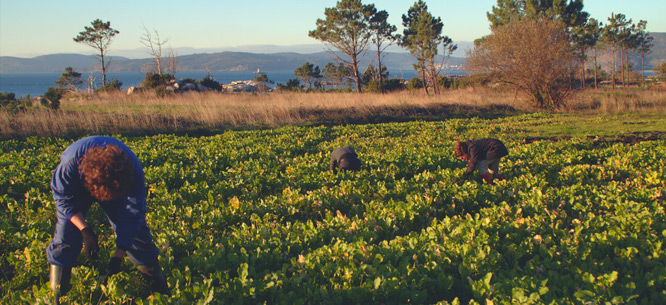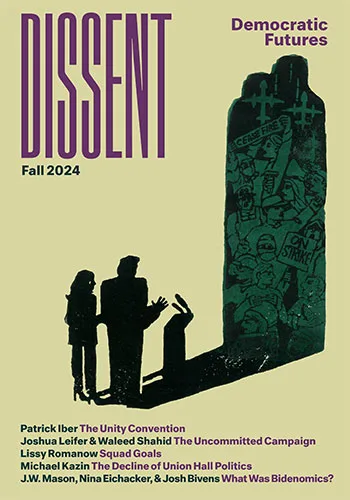The Neo-Rurals
The Neo-Rurals
Spain’s “lost generation” heads for the hills.

The opening scene of Pedro Almodovar’s 2006 film Volver finds Penelope Cruz and her teenage daughter cleaning the family tomb in a rural cemetery. A middle-aged friend appears and, after enthusiastically greeting them, begins cleaning another grave; the name inscribed on the tombstone is her own. The daughter is quizzical: why would this healthy woman maintain her future burial site with such gusto? She asks her mother, and Cruz replies that it is the custom in the village: everyone invests in their plot and gets ready to die.
This is emblematic of what villages have until recently stood for in Spain. Almodovar’s villagers are mostly black-clad widows who believe in ghosts; younger generations breeze in for monthly visits before quickly retreating back to Madrid or Barcelona. Incidentally, the title of Almodovar’s film—Volver, to go back—is a fitting description of a trend that is making his portrayal of the country’s pueblos look a little dated. Today, people are coming back to the villages—not wizened grey retirees who want to spend their last days tending the garden but young people retreating from the financial crisis. With unemployment nearing 40 percent in some provinces, many have given up city life after years of looking for work and struggling to afford urban living. Their answer has been to go back to the village, in a demographic shift that some have already started to call “rurbanization.”
The village has long been a central trope in discussions of Spanish society: the country was late to modernize and had a largely rural population until well into the Franco years, which ended in 1975. Franco’s government both honored the village as a place of traditional family values and religious devotion and encouraged emigration to cities in order to ameliorate desperate rural poverty. Villages were gradually depopulated and simultaneously romanticized in the national psyche; add to the black-clad widows the leitmotif of white-washed houses and old gentlemen drinking espressos in the plaza. All of these clichéd images of village life are as important to Spaniards’ conception of their own recent past as they are ubiquitous in tourist guides. Yet these scenes grew increasingly uncommon as employment boomed in growing industrial and tourist cities in the 1980s. The pueblo was no longer a site of everyday multi-generational life. After Franco’s death in 1975, the village became antithetical to the “new Spain.” Rural areas had dismal economic prospects and younger people often found them antiquated and stifling as cities became “Almodovarian” oases of sexual freedom, artistic expression, and prosperity. And although the rural-urban divide was alleviated somewhat in the 1990s—as Spain flexed its economic muscles and urban areas generated revenue that was used to improve infrastructure, build schools, and develop agricultural technology in rural regions—the basic template stayed the same. Until now.
Spain’s intractable fiscal crisis has brought with it widespread disappointment with cities. Since 2008, a “lost generation,” raised on the tales of financial betterment from EU cohesion, has graduated from university expecting well-paying jobs on par with their northern European neighbors. What they have found instead is mass unemployment and a new era of emigration evocative of the early twentieth century, when thousands of Spaniards left the Iberian peninsula in search of more robust economies and escape from fascism. Those who remain in Spanish cities are often confronted with a high cost of living paired with chronic unemployment. Day by day, newspapers crank out stories of the new urban dispossessed: large families living on a single pension, many of them on the brink of foreclosure and watching their neighborhoods empty out around them; thirty-something ex–postal workers digging through dumpsters for their next meal; retiree couples choosing to commit suicide rather than face eviction. It is this economic reality that has driven tens of thousands of people back to the land and created an unlikely new class of “neo-rurals.”
In re-embracing the village as a social model, many younger Spaniards have rejected not only big-city life but also the excesses of the property boom that created ghost towns filled with empty tourist flats. They see pueblo life as an opportunity to revive the principles of self-sufficiency, moderation, and closeness to the land. A young man who recently moved from Valencia to his grandparents’ village described the urban exodus to me as a stand against wastefulness and for simplicity, adding that the only other option he saw was to move to another EU country—which would have meant severing his close family connections.
The “neo-rural” lifestyle has largely meant the opposite, sending thousands of young people back to their ancestral homes, which typically remain in the family. Sometimes, the generation of grandparents who saw their own children leave for urban jobs are there to greet their grandchildren. Other times, their memories simply live on as a part of the family home—much like in Volver, where the protagonists are untroubled by the specters that wander through the village.
The government has struggled to produce an accurate count of the trend because many people remain registered in cities (both to avoid the bureaucratic hassle of changing their status and, for some, in the hopes that they will eventually return), but academics have counted well over 100,000 neo-rurals. The “lost generation” has reanimated rural life.
But does “rurbanization” reflect a genuine ambition on the part of young people or is it simply a fallback measure? At this stage, it’s hard to tell. What is well established is that Spain’s economic crisis has hit millennials particularly hard: since 2012, over half of Spaniards under thirty have been out of work (the current youth unemployment rate, at 55 percent, is second in the EU only to Greece’s). The property market was frothing with so many euros in the early 2000s that many young men left high school to work in construction, against the will of their parents, because even the most basic jobs in construction often paid double the salary of college graduates. But today, they have joined their college-educated counterparts among the ranks of the unemployed.
Some commentators have taken to calling millenials ninis (short for “ni estudia, ni trabaja”—neither in school nor working), while others have opted for mileuristas (those who live on less than a thousand euros a month). For the unemployed majority among Spain’s millennials, though, the days of living on a thousand euros seem positively dreamy. No wonder so many are leaving the job market altogether and heading back to the village.
Some demographers have publicly fretted that the slowdown of urban growth due to both the rural revival and the exodus abroad will have a lasting impact on the economy; when it finally does recover, they fear, skilled workers will be long gone. Economists also worry that the crush of austerity measures and the intra-EU brain drain will slowly began to reverse economic gains made in the past twenty years in Spain. This has stoked fears of a return to the previous geopolitical order, with an apron of impoverished southern European countries clinging to a prosperous, industrial northern core.
Often, village newcomers have no great spiritual connection with their home pueblo: it was after all their parents who left in the economic scramble of the 1970s and they grew up citified in Málaga, Seville, or Bilbao. The trek home has provided them a direct link to grandparents and the relics of pre-democratic Spain: young urbanites clean off the dust in village homes, rearrange lace tablecloths and clunky antique furniture, and dedicate a drawer of the credenza to rolling papers. They struggle with garden tasks and proudly eschew the creature comforts of the city, while their truly rural neighbors look on with horror at the more affluent newcomers who dress in rags and bathe in the creek.
The most dedicated of the back-to-the-land enthusiasts share the dreams of green radical counterparts in North America and elsewhere in Europe: their ideal is to farm, barter, and make art. Many newcomers revive their family’s dormant gardens and orchards, often while elderly neighbors—who remember these tasks as an obligation—watch with amusement. The more politically conscious neo-rurals preach locavorism, organic farming, and a broader revival of the agricultural economy as responses to the ecological destruction caused by the housing boom: over Spain’s decades of growth, much of the formerly rural coast was paved over for hotels and second homes by citizens of the same northern European countries bludgeoning the nation with austerity. Many young Spaniards have come to regret the ecological sacrifices made for what now looks like an economic chimera. In reclaiming the pueblos, which for the most part escaped the real estate bubble, they are less inspired by rural life in the nineteenth century than by the example of the bearded socialist mayor of Marinaleda, Andalusia, who started a cooperative village by expropriating land from a Spanish royal in the late 1970s.
But Spain’s young left (epitomized by the upstart party Podemos, which had a strong showing in last May’s European Parliament elections) remains reluctant to claim village life as its ideal. Indeed the pueblo is still a favorite symbol of the right, which aims to show that only the protection of traditional values will steer Spain through the current crisis. While many returnees have happily festooned themselves in the countercultural trappings of the 1970s commune—hand-sewn clothes, marijuana plants—others have argued that the backbone of the country was and still is the church, local community, and family. Such sentiments have formed part of a broader cultural and moral backlash to the economic crisis, which has prompted a serious reexamination of the post-Franco political order. Widespread resentment of the political class and its moral spinelessness has taken diverse forms. In Catalonia, it has helped foster a resurgent nationalism, fueled by indignation that the spoils of Barcelona’s industrial wealth are being used to foot the bills for poorer provinces. Elsewhere, it is mixed with anger at the relinquishment of Catholic values: a proposed ban on abortion, which was narrowly defeated, is just one example. The cherished archetype of the village lends itself well to the rhetoric of those who feel that the country has embraced LGBT rights too quickly or that cities like Madrid and Barcelona have become too receptive to immigrants.
The neo-rural movement is also connected with historic anti-urban sentiments that have haunted the country for decades. In the Civil War, some villages harbored republicans fighting the injustice of latifundistas who controlled villages and rural areas from the comfort of the provincial capital, while other pueblos were scandalized by agnosticism, feminism, and syndicalism sweeping urban areas. That is to say, both sides of the political coin have long been able to scapegoat urban life while locating the spiritual heart of the nation in the countryside.
For now, the neo-rurals mostly lean left. But whether their push to de-urbanize truly represents a social movement remains in question. What kinds of solidarity and political change can be created by embracing rural life? Long-term rural residents, who watched Spain become one of Europe’s major agricultural exporters, are keenly aware of their placement in commodity chains and an international economy, while neo-rurals sometimes imagine their efforts to take place in a hermetically sealed bubble. Still, the back-to-the-pueblo trend may offer an important imaginative tool to the new “lost generation” and their southern European counterparts who were promised so much and received so little.
Max Holleran is a PhD candidate in sociology at New York University.




